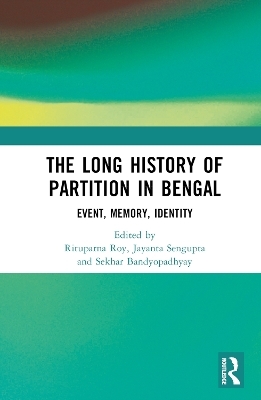
The Long History of Partition in Bengal
Routledge India (Verlag)
978-1-032-30913-2 (ISBN)
This book focuses on the aftermath of the 1947 Partition of India. It considers the long aftermath and afterlives of Partition afresh, from a wide and inclusive range of perspectives and studies the specificities of the history of violence and migration and their memories in the Bengal region. The chapters in the volume range from the administrative consequences of partition to public policies on refugee settlement, life stories of refugees in camps and colonies, and literary and celluloid representations of Partition. It also probes questions of memory, identity, and the memorialization of events.
Eclectic in its theoretical orientation and methodology, this book will be of interest to scholars and researchers of partition history, colonialism, refugee studies, Indian history, South Asian history, migration studies, and modern history in general.
Rituparna Roy is Initiator, Kolkata Partition Museum Project and Managing Trustee, KPM Trust. Jayanta Sengupta is Director, Alipore Museum, Kolkata, and former Director of Victoria Memorial Hall, Kolkata, India. Sekhar Bandyopadhyay is Emeritus Professor of History at Victoria University of Wellington, where he was previously the director of New Zealand India Research Institute.
Introduction: Partition and its Afterlife in Bengal Part I: Partition and refugees 1. Of Conflict and Cooperation: The Material Implications of British India’s Partition 2. Divided Landsapes, Fragmented Identities: East Bengal Refugees and their Rehabilitation in India, 1947-79 3. Refugeehood in the Eyes of the Refugees: Voices of the Victims of Displacement Part II: Memory, rememory and postmemory 4. Frozen time, partitioned mind: Tales of seeking refuge in West Bengal after partition 5. Life Stories and Material Objects: Revisiting the Memory of the 1947 Bengal Partition 6.Spaces of Anamnesis: The Partition of India and An/Other Bengal 7. The “Lost” Land of Barisal: “Crafting” a “Nostalgia” of East Bengal and the “Pain” of Partition 8. Partition’s Women: Inherited Memories of Remarkable Lives and Times 9. ‘Creation of a Women’s Sphere: Adjusting to an “Alien” Terrain in Post-Partition Bengal 10. ‘Moving memories: Remembering, and forgetting, the Partition of Bengal between South Asia and the United Kingdom Part III: Cultural representation and memorialization 11. Katha and Myths at the Interface of the Village and the Nation 12. Memory as cinematic praxis: The art of Ritwik Ghatak 13. The (im)possibility of representing genocidal violence: Jewish Museum Berlin, Amritsar Partition Museum and a case for a Partition Museum in Kolkata 14. Kolkata Partition Museum: Material Memory through Subaltern Narratives of Involuntary Migration
| Erscheinungsdatum | 15.02.2024 |
|---|---|
| Zusatzinfo | 18 Halftones, black and white; 18 Illustrations, black and white |
| Verlagsort | London |
| Sprache | englisch |
| Maße | 156 x 234 mm |
| Gewicht | 712 g |
| Themenwelt | Geschichte ► Allgemeine Geschichte ► Neuzeit (bis 1918) |
| Geschichte ► Allgemeine Geschichte ► 1918 bis 1945 | |
| Geschichte ► Allgemeine Geschichte ► Zeitgeschichte | |
| Geisteswissenschaften ► Geschichte ► Regional- / Ländergeschichte | |
| Naturwissenschaften ► Geowissenschaften ► Geografie / Kartografie | |
| Sozialwissenschaften ► Soziologie ► Spezielle Soziologien | |
| ISBN-10 | 1-032-30913-X / 103230913X |
| ISBN-13 | 978-1-032-30913-2 / 9781032309132 |
| Zustand | Neuware |
| Haben Sie eine Frage zum Produkt? |
aus dem Bereich


